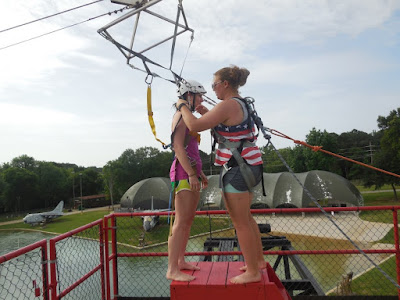 |
| Aviation Challenge lake |
 |
| Team Zarya is excited to be rescued! |
 |
| Suited up and ready to go! |
 |
| Final check of the harness |
After parachuting, we did a capsule sinking simulation. We had to pretend that we were in an aircraft of some sort that was going down. After the capsule sank into the water, we had to exit through an open door feet first, swim to a near by pole and count off to make sure everyone made it out safely. After everyone was accounted for, we swam to a helicopter that rescued us by lowering a basket and raising us out of the water.
 |
| Alan as the commander and myself as the pilot |
 |
| Waiting for the helicopter to rescue us |
 |
| In the rescue basket |
After finishing our simulations at Aviation Challenge, we changed clothes, headed over to the simulators and started our Atlantis Mission. I was a bit nervous but there's something about being in that flight suit that makes you think you can really fly a space shuttle (even if you fly it backwards). Greg, Kat, Kaci and I got in the Orbiter and started our pre-flight checklists.
Crew leader, Jen, taking a selfie of Team Zarya before the Atlantis mission
 |
| Orbiter crew before Atlantis Mission |
 |
| Commander and Pilot |
 |
| Going through the manual |
 |
| View from Mission Control |
 |
| Pilot making sure he knows his switches |
 |
| Mission Specialists performing an EVA |
 |
| In case you were wondering, yes, there is a potty in the Atlantis orbiter, however, it is not operable. |
 |
| Team Zarya, Orbiter Crew....Mission Complete! |
After our Atlantis Mission and Aviation Challenge, we were all pretty worn out and hungry. Even though we could feel the exhaustion from the first three days, our excitement for what was next keep us going. Thankfully, lunch was next. After some food and a short rest we went to our Rocketry Workshop.
Wes Kennedy, Team Unity's Crew Leader, lead our workshop on Rocketry. We had a great time assembling our rockets, helping one another, and decorating!
Alan (Maryland), Greg (Poland) and Iskender (Russia)
Assembling the engine
Gluing the shock cord
Threading the shock cord through the body
Securing the parachute
Almost ready!
There she is! Ready for a paint job.
Only teacher from Louisiana...had to paint it purple and gold!
Teachers painting their rockets
Mrs. Rath with her LSU rocket
Team Zarya's rockets
Our rockets needed to dry and set up overnight. We launched them the next day.
Next up was an IMAX movie called "Journey to Space". We had a few minutes before the movie to get popcorn and drinks. I was a little worried about falling asleep during the movie, as I usually do, however, the show was so captivating that I had to stay awake! "Journey to Space" is about NASA's history in space flight and the future trip to Mars using the Space Launch System (SLS). The show was fantastic and I would love to see it again! Here's the trailer...
We had some free time after the movie to explore the museum and/or rocket park. A few of us decided to check out the Robot Zoo that is currently featured in the museum. Robotics are use to demonstrate how parts of animals and insects function in nature. Click here for more information on the Robot Zoo.
They had a rock wall in the museum that was free to climb. I was a bit overconfident on my first climb. I decided to move down to an easier route and was able to reach the top.
Next was dinner. I wasn't very hungry, due to the large popcorn that I ate during the movie.
After dinner, we took a group picture on the "lunar surface" in front of the lunar module in Rocket Park.
After our photo op on the lunar surface, we headed over to the Davidson Center to do a little filming and meet with our team leader, Jen, about our second mission. Sylvia, Jen D., Kaci and I dawned our flight suits and pretended to be astronauts walking the walkway to board the space shuttle.
After being silly and filming our short video we met with our team leader to get our assignments for the Orion mission. My position is CapCom in Mission Control! As CapCom my job is to relay information from Mission Control to the Orion capsule and vice versa.
Next was our training for Orion. We spent about 45 minutes practicing our positions, making sure everyone knew what to do and how the mission would run.
View from Mission Control. CapCom on the left and the Prop next to me. Notice the screens above us that give us views of each part of the mission.
After our practice we pointed out our hometowns to one another.
Iskender showing us where he lives in Russia
Mrs. Rath pointing out Baton Rouge, Louisiana
Day 3 was quite a busy day. We were all pretty tired and ready for bed. We boarded the bus, went back to the dorm and rested up for day 4.
Team Zarya in the elevator of the dorm at the end of day 3!








































